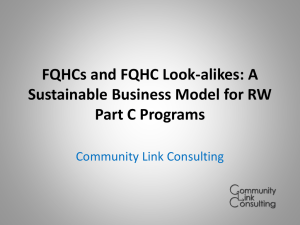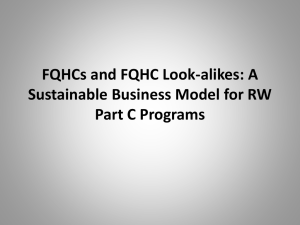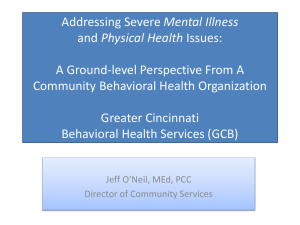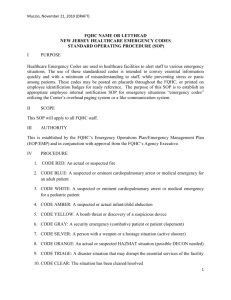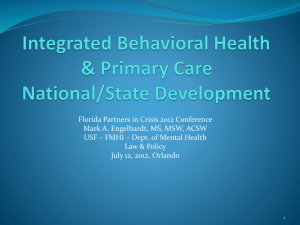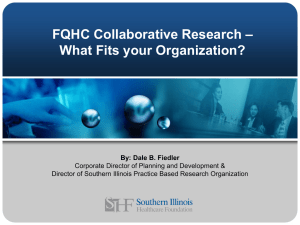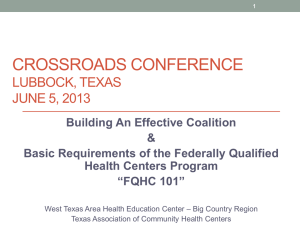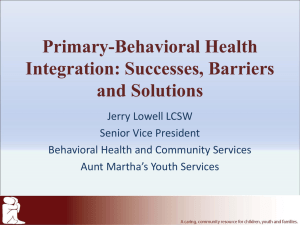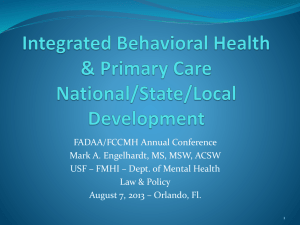Title of Presentation - Collaborative Family Healthcare Association
advertisement
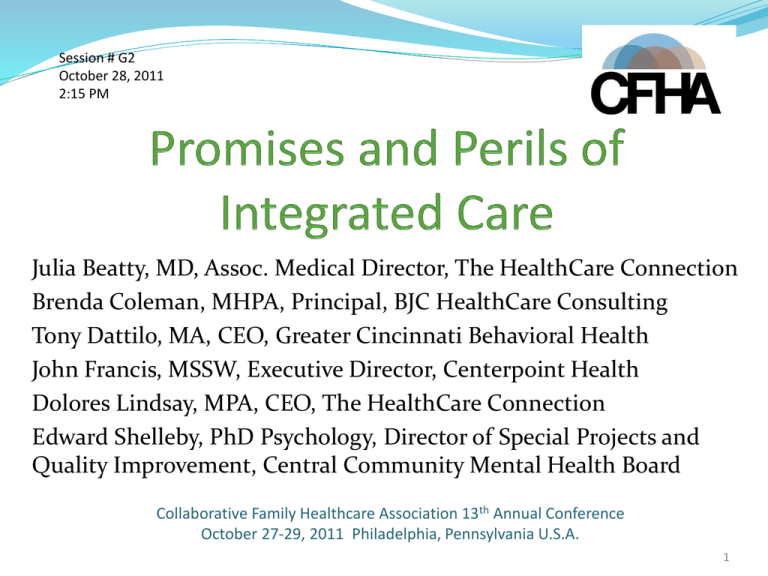
Session # G2 October 28, 2011 2:15 PM Julia Beatty, MD, Assoc. Medical Director, The HealthCare Connection Brenda Coleman, MHPA, Principal, BJC HealthCare Consulting Tony Dattilo, MA, CEO, Greater Cincinnati Behavioral Health John Francis, MSSW, Executive Director, Centerpoint Health Dolores Lindsay, MPA, CEO, The HealthCare Connection Edward Shelleby, PhD Psychology, Director of Special Projects and Quality Improvement, Central Community Mental Health Board Collaborative Family Healthcare Association 13th Annual Conference October 27-29, 2011 Philadelphia, Pennsylvania U.S.A. 1 Faculty Disclosure I/We have not had any relevant financial relationships during the past 12 months. 2 Learning Assessment A learning assessment is required for CE credit. 3 Need/Practice Gap & Supporting Resources People in Ohio with Severe Mental Illness (SMI) die 32.2 years earlier than the rest of the population (Miller, Paschall, Svendsen, 2006) Studies show that 60% of patients with SMI die of preventable health conditions Access to primary care is limited/a problem for SMI clients By report a large percentage of SMI clients have poorly controlled chronic health problems, e.g., Diabetes, Hypertension Care for SMI clients is fragmented–not coordinated. 4 Objectives 1. Identify the key contributing factors for the successful integration of primary care and behavioral health services 2. Articulate the reasons for setting realistic performance objectives. It’s A Journey! 3. Identify the pros and cons of partnering with a Federally Qualified Health Center (FQHC) 5 Expected Outcome At the end of this session, participants will: Understand the benefits of integrating care using the co-location model Identify barriers and success factors Articulate pros/cons of partnering with a FQHC Understand the importance of setting realistic performance expectations Recognize and know: “Rome was not built in a day.” 6 OUR PARTNERSHIP CO-LOCATION MODEL Independent, Parallel Clinical Processes Behavioral Health Clinic Site MH intake Psychiatrist Case Manager Client Referral Partnership’s Client Flow Supervising PC Physician MD & APN PC intake Support Staff: LPN & MA 7 The Partners The HealthCare Connection Federally Qualified Health Center (FQHC) National Committee for Quality Assurance , Patient Centered Medical Home recognition Seven locations serving 18,000 patients annually Mission: Provide quality, culturally sensitive and accessible primary care focusing on the medically underserved, underinsured and uninsured in northern Hamilton County Ohio and surrounding areas Oldest FQHC in Ohio. Founded in 1967 www.healthcare-connection.org 8 The Partners Centerpoint Health Comprehensive behavioral health provider formed in 2008 through merger of three local community behavioral health agencies Five office locations + four treatment sites serving 7,000 clients annually in Hamilton County, Ohio Mission: Strengthen communities served by providing the best quality mental health care to children, adults and families Services: Adult Outpatient, Child Case Management, Adult Case Management, Adult Support, and Crisis & Prevention, including the 24/7 suicide hotline for Hamilton County www.centerpointhealth.org 9 The Partners Central Community Health Board of Hamilton County A Private, non-profit corporation founded in 1970. Provides comprehensive mental health and drug treatment, alcoholism referral services and HIV prevention services to Hamilton County, Ohio residents. Mission: Provide the best possible mental illness, substance abuse and HIV prevention and treatment services Services: Case management, psychotherapy, partial intervention, emergency and long-term residential, psychiatric , addictions and methadone treatment. www.cchbinc.com 10 The Partners Greater Cincinnati Behavioral Health Services A comprehensive mental health agency serving adults with severe mental illness in the Cincinnati area. 300 care professionals serve over 4,000 adults annually Rehabilitation services at 10 locations Provides psychiatric, nursing, counseling, care management, residential, vocational, day programs and others SMI clients include the homeless, incarcerated, and those with many dual disorders. www.gcbhs.com 11 Key Factors for Successful Integration Shared mission, goals, and be comfortable with risk. Roles and responsibilities clearly defined (MOU) Handout 1 Committed boards, executives, and senior leaders Mutually understanding the need to work to determine the right payer mix and be realistic about what it will take to achieve objectives (financial and service) 12 Key Factors for Successful Integration Management level “champion” in each organization The “right” providers and staff in the “right seats on the bus” Strong inter/intra organizational communication systems Primary care office location easily accessible to clients and psychiatrists Handout 2 13 Pros of Partnering with a FQHC Have similar missions Experience serving underserved at-risk populations Primary care billing system in place Have a system approach to health care Are familiar with public health policy Federal level support (i.e. funding and enhanced Medicaid rate) 14 Pros of Partnering with a FQHC Shared client populations. May already serve SMI individuals at other locations Federal level support (i.e. funding and enhanced Medicaid rate) PCMH expectation and requirements closely mirror behavioral health accreditations (i.e. CARF) 15 Cons of Partnering with a FQHC Learning curve. Operates in a different world (billing, reimbursement, funding, clinical language) FQHC not in service area FQHC not widely known or respected in the community. Is this the right partner? FQHC and behavioral health agency uncertain or lukewarm about establishing a relationship 16 Set Realistic Performance Measures/Objectives Determine the right number and types of objectives. Measure what really matters. This will help in: Making administrative decisions Course correcting as needed Building success Finding/applying for new money 17 Set Realistic Performance Measures/Objectives Maintaining funding Clinical decision making Replication Maintaining focus 18 Our Primary Care Performance Measures # Visits % Insured Visits # Visits/Work Day % Appointments Kept # Unduplicated Patients 19 Our Primary Care Performance Measures % Insured Patients Net Gain/Loss Revenue/Visit as % of Cost/Visit Cost/Patient Handout 3 20 Our Primary Care Performance Measures % Diabetic Patients with most recent HgA1c < 8 % Hypertensive Patients with most recent BP under 140/90 21 Questions & Answers 22 Session Evaluation Please complete and return the evaluation form to the classroom monitor before leaving this session. Thank you! 23

